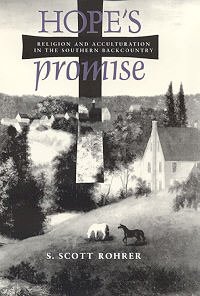
|
S. Scott Rohrer. Hope's Promise: Religion and Acculturation in the Southern Backcountry. Tuscaloosa: University of Alabama Press, 2005. 304 pages. 0-8173-1435-0. Reviewed by Ted Ownby, For the Journal of Southern Religion.
| "The work focuses on Anglo-Moravians in the town of Hope who never had the goal, common to many Moravians, of separating themselves from other people in an ideal village of fellow believers." | |
Rohrer's primary argument is that as adherents to a religion of the heart and soul who placed a particular emphasis on
soul-winning, Moravians were part of a broader evangelical culture that helped people who were isolated from each other by language and background and who were inclined to extend their meanings of community and to identify with, care about, and learn from a broader range of people. Specifically, Moravians who spoke different languages and came from colonies in Maine, Pennsylvania, Maryland, and from England and Germany influenced and eventually intermingled with each other. The work focuses on Anglo-Moravians in the town of Hope who never had the goal, common to many Moravians, of separating themselves from other people in an ideal village of fellow believers.
The alternative to this argument about acculturation—the alternative Rohrer rejects—would be a story of decline, in which people with high ideals gave up on their mission, and succumbed to the uncertainties of the frontier or the temptations of slavery, wealth and comfort. So much scholarship on American Protestantism tells the story of declining ideals that it is intriguing to read an argument about the building, rather than the loss, of community.
Among works in American religious history, this work reminds one of older 1970s scholarship on Puritan villages in New England because, like Hope's Promise, they analyze the interrelations of theology, demography, land use, family organization and size, and community membership. Like those older books, this volume has extraordinary and admirable detail. We get to know the people as individuals rather than as social types. More common to contemporary scholarship, the book also pays admirable attention to language and ritual in building and sustaining community life.
Despite its strengths, this is not a great, path-breaking book. We who study and teach southern religious history need to read it to fill in a gap in our own knowledge. It might be a useful book in a graduate course on early southern history, especially southern religious history, but it seems unlikely to be a successful book to assign to undergraduates. The biggest problem is that the subtitle suggests a scope of analysis the book does not deliver. Even though the book discusses the Moravians as they came to value discussions of freedom during the American Revolution, describes how they learned to appreciate the potential of Methodists' camp meetings, and demonstrates how they came in the antebellum years to own slaves and try to convert them, the volume remains a study of a tiny group of people in a small place. It is not clear how the issues of acculturation apply to the larger groups who made up the majority of southern religious believers, although the question is worth asking. Still, the book succeeds at its most fundamental goal of telling a new and interesting story about a largely unstudied group in American history.
Ted Ownby, University of Mississippi
© 1998-2005 by The Journal of Southern Religion. All rights reserved. ISSN 1094-5253




